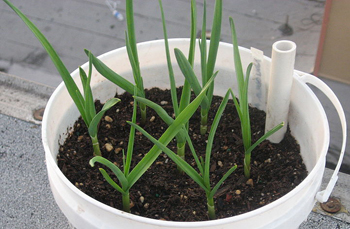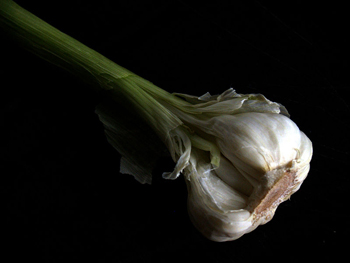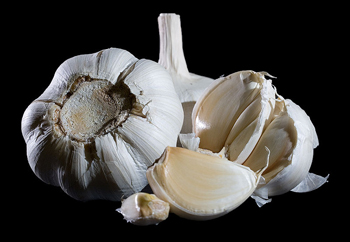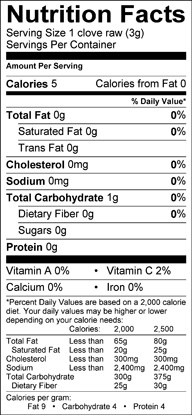Contents:
Common Names | Parts Usually Used | Plant(s) & Culture | Where Found | Medicinal Properties | Biochemical Information
Legends, Myths and Stories | Uses | Formulas or Dosages | Nutrient Content | How Sold | Warning | Resource Links | Bibliography
Scientific Names

- Allium sativum L.
- Liliaceae
- Lily family
Common Names
- Clove garlic
- Nectar of the gods
- Camphor of the poor
- Da suan (Chinese name)
- Rashona (Sanskrit name)
- Tricolor garlic
- Stink weed
Parts Usually Used
Bulb
Back to Top

Description of Plant(s) and Culture
Garlic is a perennial plant; the bulb is compound, consisting of individual bulbs, or cloves, enclosed together in a white skin. The stem is simple, smooth, and round and is surrounded at the bottom by tubular leaf sheaths from which grow the long, flat linear leaves. The leafless stem is topped by a rounded umbel of small, white, usually sterile flowers, among which grow 20-30 small bulbils. The entire umbel is at first enclosed in a teardrop-shaped leaf (pointing upward) which eventually falls off.
Other varieties: Bear’s garlic (Allium ursinum) used much like regular garlic; Serpent garlic
Back to Top

Where Found
Widely cultivated as one of the most common kitchen herbs. Occasionally found growing wild. Found along roadsides and fields from New York to Tennessee, Kentucky, Missouri.
Back to Top
Medicinal Properties
Alterative, anthelmintic, antispasmodic, carminative, cholagogue, digestive, expectorant, febrifuge, antiviral, antibiotic, antiseptic, stimulant
Back to Top
Biochemical Information
Unsaturated aldehydes, allicin, allyl disulfides, calcium, copper, germanium, iron, magnesium, manganese, volatile oils, phosphorus, phytoncides, potassium, selenium, sulfur,
Back to Top
Legends, Myths and Stories
In ancient times, the Chinese, Romans, Egyptians, Hindus, and Babylonians all believed that garlic cured intestinal orders, infections of the respiratory system, relieved flatulence, treated skin diseases, wounds, worms and delayed the signs of aging.
Garlic is even mentioned in the Calendar of the Hsia, a book of 2,000 years before Christ. It is called Hsiao-suan to distinguish it from Allium scorodoprasum which is called Ta-suan.
The odor of garlic is so powerful and penetrating that if applied to the feet, its scent is in the breath and when garlic is eaten, it is communicated through the pores of the skin, even to the fingers. It may be detected in the flesh of animals that have eaten garlic; or even in the eggs of fowls that have eaten it.
In Egypt several thousand years before Christ, garlic was given to laborers. The Bible records that the Israelites who lived in Egypt at the time of Moses also ate garlic before their exodus out of that country. The Romans gave garlic to their laborers; and their soldiers ate it in the belief that it inspired courage. Thus it was dedicated to Mars, the Roman god of war.
“When Satan stepped out from the Garden of Eden after the fall of man, Garlick sprang up from the spot where he placed his left foot, and Onion from that where his right foot touched”. Such is the legend some herbalists attributed to the Mohammedans.
Since the ancients believed that many diseases were the result of evil spells, garlic with its effective medicinal qualities was thought to possess magical power against evil; thus it was used in many charms and countercharms. In Greek legend, Odysseus used moly, a mild garlic, as a charm to keep the sorceress Circe from turning him into a pig. In the Middle Ages, garlic was considered strong against the evil eye, witches, and demons. Another tradition still held in rural New Mexico is the use of garlic as a charm to help a young girl rid herself of an unwanted boyfriend. She first puts a piece of garlic and two crossed pins in a spot where two roads intersect, and then she must get the boy to walk over the charm without noticing it. If the task is accomplished successfully, the boy will miraculously lose all interest in her.
During the time of the Pharoahs, when Egypt was at its peak of power, garlic was given to the laborers and slaves. The common people had garlic included in the diet to help protect them from disease. The Ebers Papyrus, an Egyptian medical papyrus dated sometime around 1500 BC, mentions garlic 22 times as a remedy for a variety of diseases. Hippocrates, the father of modern medicine, used garlic as a laxative, a diuretic, for tumors of the uterus, leprosy, epilepsy, chest pains, toothaches, and for wounds incurred during battle. Aristotle also mentions the value of garlic and Aristophanes used garlic as a treatment for impotence.
The yogis used garlic as a medicine, but did not recommend it as a food or spice because of its irritating properties.
The juice of garlic is said by the old-timers to be the best and strongest cement that can be adopted for broken glass and china, leaving little or no mark, if used with care.
In the 1950’s, Dr. Albert Schweitzer used garlic to treat cholera, typhus, and amebic dysentery while he was working in Africa as a missionary. The Soviet army relied heavily on garlic during World Wars I and II, it earned the name “Russian penicillin.”
During the Great Plague epidemic, some herbalists avoided the deadly disease by eating large amounts of garlic and wearing garlic strands around their necks. To date, it has not been determined whether the garlic’s antibiotic properties protected these people against the plague, or whether the foul stench of the herb discouraged others from getting close enough to spread their infection.
Since 1979, Gilroy, California, known as the “Garlic Capital of the World,” has hosted the Annual Garlic Festival in celebration of the annual garlic harvest. Held the last weekend of July each year, the event is a 3 day gourmet food and wine tasting party drawing more than 140,000 garlic fans. 90% of the United States garlic crop is grown in Gilroy and its environs. American humorist Will Rogers once said of Gilroy “the only town in America where you can marinate a steak by hanging it on the clothesline.”
Back to Top
Uses
A natural antibiotic. Protects from infection, detoxifies the body, promotes sweating, strengthens blood vessels, lowers blood pressure. Aids in treatment of arteriosclerosis, hemorrhoids, impotence, hysteria, edema, asthma, arthritis, good against all venom, spider bites, and poisons, tuberculosis, circulatory problems, colds, bronchitis, fever, flu, toothache, headache, earache, digestive problems, constipation, genito-urinary diseases, heart disorders, reduces cholesterol if eaten raw, insomnia, liver disease, jaundice, sinusitis, dysentery, diarrhea, diabetes, gastritis, rheumatism, ulcers, and yeast infections. Good for all diseases, infections, fungus, earache, some cancers, and bacteria. Taken internally it will destroy worms (used as an enema or made into a paste with olive oil inserted into the rectum), and used externally, blended with a little sesame or olive oil, it will rid the skin of parasites. However, its strong odor may repel humans as well as parasites. Doesn’t do much for halitosis though, unless the odorless tablets are used. Externally, helps old sores, bruises, falling hair, wounds.
Garlic’s strong aromatic compounds are excreted via the lungs and the skin; eating fresh parsley may eliminate odor on the breath. According to one reference, by eating baked beet-root the offensive smell is entirely taken away.
It is an effective antibiotic for staphylococcus, streptococcus and salmonella bacteria and it is effective against bacteria that are resistant to standard antibiotic drugs.
Plant cloves of garlic near fruit trees, cabbages, beans, berry canes or any other susceptible crop to keep away aphids or Japanese beetles. (Might taint underground crops).
Back to Top
Formulas or Dosages
Gather bulbs in the fall.
Juice: take 1/2 tsp. of the juice pressed from the bulb, thinned with water,
Cold extract: let several cloves of garlic stand in
Cloves: for coughs, take grated garlic mixed with honey.
Tincture: let 1/2 lb. peeled cloves soak in
Stir-frying the cloves of garlic for a few minutes will help eliminate the garlic breath and aftertaste.
Back to Top
Nutrient Content
Copper, germanium, magnesium, manganese, phosphorus, potassium, vitamins B1, B2, and C, and zinc.

How Sold
Odorless tablets
Garlic powder
Garlic salt
Fresh in the grocery
Back to Top
Warning
Pregnant women should use in small amounts as garlic is a mild emmenagogue (encourages menstrual flow); also therapeutic doses during pregnancy and lactation can cause indigestion problems such as heart-burn, and nursing babies may dislike the taste of breast milk.
The essential oil extracted from the bulbs is extremely concentrated and can be irritating. Eating 10 or more raw garlic cloves per day can be toxic and in some cases can trigger an allergic reaction.
Back to Top
Resource Links
Garlic Component is an Anti-Aging Superhero
Herbs That are More Effective in Treating Lyme Than Antibiotics
LiveStrong.com: Garlic and Stomach Problems
LiveStrong.com: Garlic & Heartburn
LiveStrong.com: Natural Methods for Lowering Triglycerides & Cholesterol
MayoClinic.com: Cholesterol-lowering supplements
National Center for Complementary and Alternative Medicine: Garlic
U.S. National Library of Medicine: Garlic
Memorial Sloan-Kettering Cancer Center: Garlic
University of Maryland Medical Center: Garlic
Bibliography
![]() The Herb Book
The Herb Book, by John Lust, Bantam Books, 666 Fifth Avenue, New York, NY. copyright 1974.
![]() Back to Eden
Back to Eden, by Jethro Kloss; Back to Eden Publishing Co., Loma Linda, CA 92354, Original copyright 1939, revised edition 1994
![]() Chinese Medicinal Herbs
Chinese Medicinal Herbs, compiled by Shih-Chen Li, Georgetown Press, San Francisco, California, 1973.
![]() Indian Uses of Native Plants
Indian Uses of Native Plants, by Edith Van Allen Murphey, Meyerbooks, publisher, PO Box 427, Glenwood, Illinois 60425, copyright 1958, print 1990
 Old Ways Rediscovered
Old Ways Rediscovered, by Clarence Meyer, Meyerbooks, publisher, PO Box 427, Glenwood, Illinois 60425, published from 1954, print 1988
![]() Culpeper’s Complete Herbal & English Physician: Updated With 117 Modern Herbs
Culpeper’s Complete Herbal & English Physician: Updated With 117 Modern Herbs, by Nicholas Culpeper, Meyerbooks, publisher, PO Box 427, Glenwood, Illinois 60425, 1990, (reprint of 1814)
![]() The Complete Medicinal Herbal
The Complete Medicinal Herbal, by Penelope Ody, Dorling Kindersley, Inc, 232 Madison Avenue, New York, NY 10016, First American Edition, copyright 1993
![]() Eastern/Central Medicinal Plants
Eastern/Central Medicinal Plants, by Steven Foster and James A. Duke., Houghton Mifflin Company, 215 Park Avenue South, New York, NY 10000
![]() The Nature Doctor: A Manual of Traditional and Complementary Medicine
The Nature Doctor: A Manual of Traditional and Complementary Medicine, by Dr. H.C.A. Vogel; Keats Publishing, Inc., 27 Pine Street (Box 876) New Canaan, CT. 06840-0876. Copyright Verlag A. Vogel, Teufen (AR) Switzerland 1952, 1991
![]() The Herbalist Almanac
The Herbalist Almanac, by Clarence Meyer, Meyerbooks, publisher, PO Box 427, Glenwood, Illinois 60425, copyright 1988, fifth printing, 1994
![]() Indian Herbalogy of North America
Indian Herbalogy of North America, by Alma R. Hutchens, Shambala Publications, Inc., Horticultural Hall, 300 Massachusetts Avenue, Boston, Massachusetts 02115, 1973
Herbal Gardening, compiled by The Robison York State Herb Garden, Cornell Plantations, Matthaei Botanical Gardens of the University of Michigan, University of California Botanical Garden, Berkeley., Pantheon Books, Knopf Publishing Group, New York, 1994, first edition
 The Magic of Herbs
The Magic of Herbs, by David Conway, published by Jonathan Cape, Thirty Bedford Square, London, England. (Out of print)
![]() Planetary Herbology
Planetary Herbology, by Michael Tierra, C.A., N.D., O.M.D., Lotus Press, PO Box 325, Twin Lakes. WI 53181., Copyright 1988, published 1992
![]() Prescription for Nutritional Healing, Fifth Edition: A Practical A-to-Z Reference to Drug-Free Remedies Using Vitamins, Minerals, Herbs & Food Supplements
Prescription for Nutritional Healing, Fifth Edition: A Practical A-to-Z Reference to Drug-Free Remedies Using Vitamins, Minerals, Herbs & Food Supplements, by James F. Balch, M.D. and Phyllis A. Balch, C.N.C., Avery Publishing Group, Inc., Garden City Park, NY
 Secrets of the Chinese Herbalists
Secrets of the Chinese Herbalists, by Richard Lucas, Parker Publishing Company, Inc., West Nyack, NY, 1987.
 Taber’s Cyclopedic Medical Dictionary
Taber’s Cyclopedic Medical Dictionary, 15th Edition, F. A. Davis Company, 1915 Arch Street, Philadelphia, PA 19103
![]() Webster’s New World Dictionary
Webster’s New World Dictionary, Third College Edition, Victoria Neufeldt, Editor in Chief, New World Dictionaries: A Division of Simon & Schuster, Inc., 15 Columbus Circle, New York, NY 10023
 An Instant Guide to Medicinal Plants
An Instant Guide to Medicinal Plants, by Pamela Forey and Ruth Lindsay, Crescent Books (January 27, 1992).
 Earl Mindell’s Herb Bible
Earl Mindell’s Herb Bible, by Earl Mindell, R.Ph., Ph.D., Simon & Schuster/Fireside, Rockefeller Center 1230 Avenue of the Americas, New York, New York 10020
 The Magic of Herbs in Daily Living
The Magic of Herbs in Daily Living, by Richard Lucas, Parker Publishing Co. (1988).
![]() The Yoga of Herbs: An Ayurvedic Guide to Herbal Medicine
The Yoga of Herbs: An Ayurvedic Guide to Herbal Medicine, by Dr. David Frawley & Dr. Vasant Lad, Lotus Press, Twin Lakes, Wisconsin, Second edition, 1988.
 The Rodale Herb Book: How to Use, Grow, and Buy Nature’s Miracle Plants (An Organic gardening and farming book)
The Rodale Herb Book: How to Use, Grow, and Buy Nature’s Miracle Plants (An Organic gardening and farming book), edited by William H. Hylton, Rodale Press, Inc. Emmaus, PA, 18049., 1974
![]() Country Home Book of Herbs
Country Home Book of Herbs, Meredith Books, Editorial Dept. RW240, 1716 Locust Street, Des Moines, IA 50309-3023, copyright 1994
